The Unhealthiest Frozen Seafood Products—and What To Buy Instead
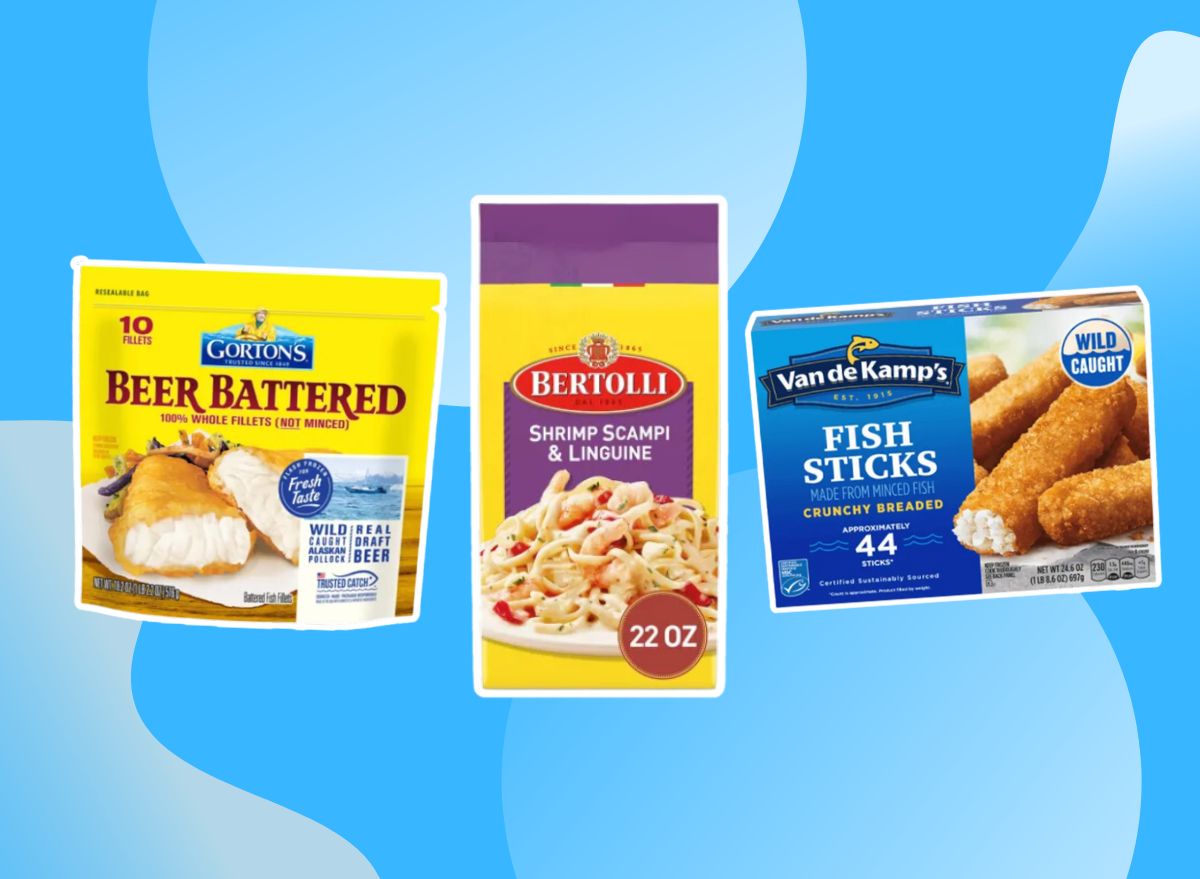
Seafood is typically seen as healthy, with the Dietary Guidelines for Americans recommending eating seafood at least twice a week. Rich in essential nutrients such as omega-3 fatty acids, protein, iron, and choline, seafood is often celebrated for its benefits for cardiovascular and brain health. Our convenience-driven lifestyles have led to the creation of frozen seafood products as a quick and easy way to incorporate seafood into our diets. These products can be a game-changer for busy people who lack the time or resources to buy and prepare fresh seafood regularly.
However, despite their convenience, not all frozen seafood products are created equal. Many of these hassle-free options are laden with unhealthy levels of added fat and sodium. Eating such products frequently could be problematic for cardiovascular health and overall well-being.
We rounded up five of the unhealthiest frozen seafood products in freezer aisles and provided five healthier alternatives for you to try instead.
How to Shop for Healthy Frozen Seafood Products
We followed several guidelines when choosing the best frozen seafood products in the freezer aisle. These guidelines informed our choices for healthier frozen seafood products.
- Lower Sodium: Many frozen seafood manufacturers pump their products full of sodium to preserve them and enhance flavor. Breaded frozen seafood products tend to have more sodium than their unbreaded counterparts, but this isn't always the case, and it's important to check the nutrition facts table. Per the American Heart Association (AHA), it's best to keep to below 2,300 milligrams of sodium per day. This is because high-sodium diets have been directly linked to issues like high blood pressure, heart disease, and early death.
- Lower Fat: The Dietary Guidelines for Americans recommend that adults get between 20% and 35% of their total calories from fat. That's about 44 to 78 grams of fat per day for someone eating 2,000 calories a day. We also considered saturated fat, which can increase your LDL levels and increase your risk of heart disease and stroke. The AHA recommends eating no more than 13 grams of saturated fat daily.
- No Additives or Preservatives: While we're still learning about the effects of these additives on health, we've opted to recommend products without artificial ingredients, colors, or flavors to ensure you get the highest quality product.
- No Breading: Pre-breaded or pre-seasoned frozen seafood can contain extra calories, fats, and sodium. Buying plain seafood allows you to control the seasoning and cooking methods, making it easier to prepare a healthy meal.
Read on to learn about the frozen seafood products we recommend taking home and those we recommend leaving at the store. Then, check out the 30 Worst Frozen Foods in America.
The 5 Unhealthiest Frozen Seafood Products
Worst: Kroger Crunchy Butterfly Shrimp
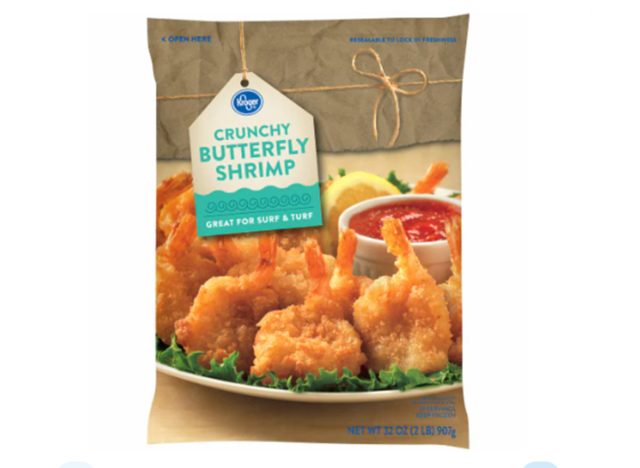
Calories: 210
Fat: 12 g (Saturated fat: 1 g)
Sodium: 400 mg
Carbs: 19 g
Protein: 7 g
Kroger Crunchy Butterfly Shrimp is made with shrimp and a breading made from wheat and corn flour. A 3-ounce serving contains 12 grams of fat—over 15% of your daily recommendations. They also contain over 17% of your daily sodium allowance. Online reviewers noted that these were mostly greasy breading with very little shrimp. They also contain several additives like sodium acid pyrophosphate, guar gum, and sodium tripolyphosphate—ingredients that some people may be trying to avoid.
Worst: Bertolli Shrimp Scampi & Linguine
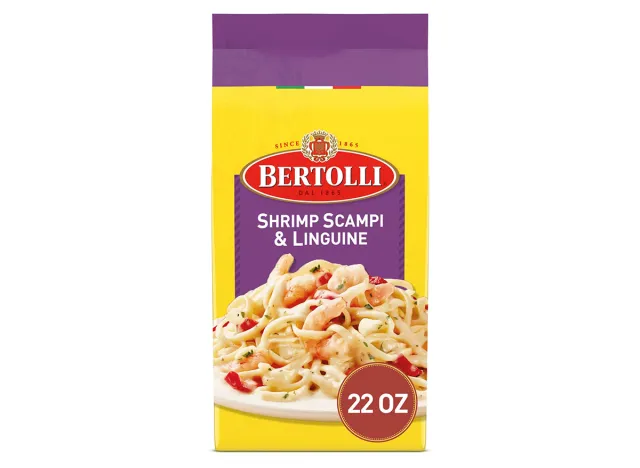
Calories: 330
Fat: 15 g (Saturated fat: 5 g)
Sodium: 2,050 mg
Carbs: 35 g
Protein: 12 g
Bertolli Shrimp Scampi & Linguine features shrimp and linguine in a creamy garlic sauce. A single serving contains 5 grams of saturated fat—almost half a day's worth. It also contains 1 gram of trans fat, which should be avoided completely. Plus, it contains a whopping 2,050 milligrams of sodium per serving—that's almost your entire day's worth of sodium in one meal. It's relatively low in protein, with just 12 grams per serving, and it contains additives like sulfur dioxide and sodium tripolyphosphate, which some people may wish to avoid.
Worst: Private Selection Wild Caught Shrimp Mac & Cheese
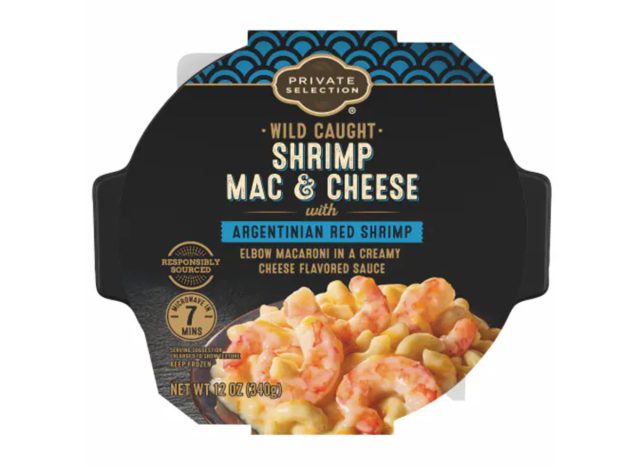
Calories: 750
Fat: 22 g (Saturated fat: 13 g)
Sodium: 2,000 mg
Carbs: 93 g
Protein: 28 g
Private Selection Wild Caught Shrimp Mac & Cheese contains shrimp, macaroni, cheese sauce, cheese, and cream. With 13 grams of saturated fat per serving, this meal takes up your entire day's allowance of saturated fat. It's also laden with sodium, with 2,000 mg per serving—almost an entire day's worth. It has one of the longest ingredient lists of any frozen seafood products we reviewed. This is one meal we'd recommend leaving in the freezer aisle.
Worst: Gorton's Beer Battered 100% Whole Fillets
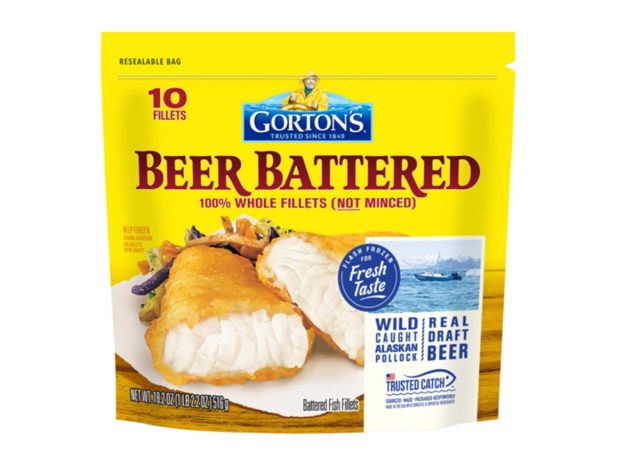
Calories: 240
Fat: 14 g (Saturated fat: 1 g)
Sodium: 450 mg
Carbs: 18 g
Protein: 10 g
Gorton's Beer Battered 100% Whole Fillets try really hard to make you think they're a healthy choice. They feature wild-caught Alaskan pollock and are Trusted Catch certified. But when you dig deeper into the nutritional facts and ingredients, you'll find they're not as healthy as they're made out to be. They contain 450 milligrams of sodium, or 20% of the recommended intake.
In addition, the beer batter adds 18 grams of carbohydrates. While there's nothing wrong with eating carbs – our brains need them to function – they should ideally come from wholesome sources like fruits, vegetables, and whole grains, not greasy beer batter. A serving of two fillets only provides 10 grams of protein, which is low for a main meal. Plus, they contain ingredients that some people may be trying to avoid, like modified corn starch, tapioca dextrin, and sunflower lecithin.
Worst: Van de Kamp's Fish Sticks
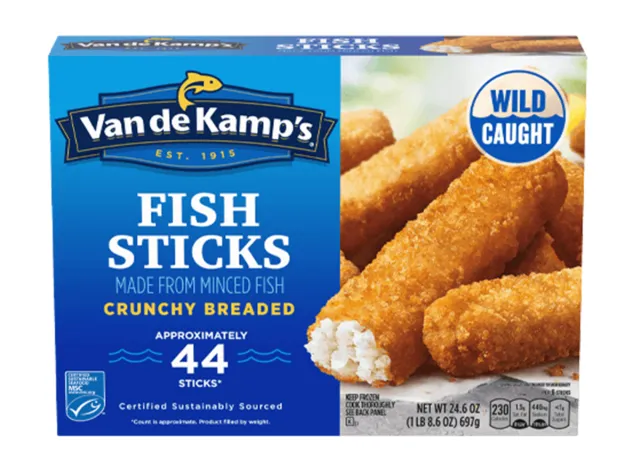
Calories: 230
Fat: 10 g (Saturated fat: 1.5 g)
Sodium: 440 mg
Carbs: 22 g
Protein: 10 g
While they're wild-caught, Van de Kamp's Fish Sticks get a thumbs down from us. A serving of six sticks contains 440 milligrams of sodium—almost 20% of the daily recommended intake. A serving only contains 10 grams of protein—not enough for a main meal. Plus, reviewers of the product noted that the ratio of bread crumbs to fish was undesirable, with the coating being so thick that you can barely taste the small amount of fish.
5 Healthier Frozen Seafood Products to Try
Best: Aqua Star Wild Pacific Salmon Fillet
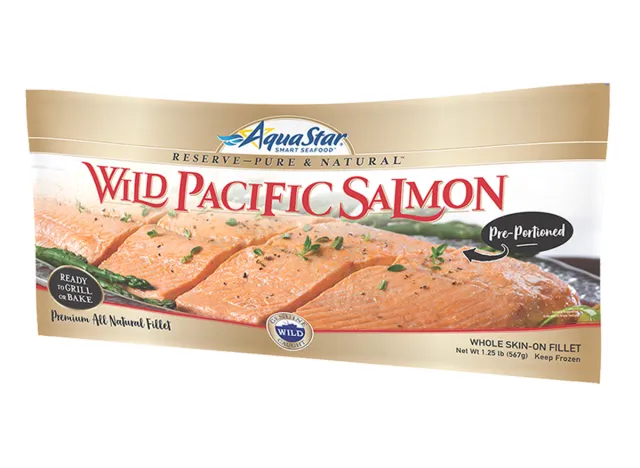
Calories: 140
Fat: 4.5 g (Saturated fat: 1 g)
Sodium: 55 mg
Carbs: 0 g
Protein: 23 g
Aqua Star Wild Pacific Salmon Fillets are higher in fat than some other types of fish, but don't worry; it's heart- and brain-healthy omega-3 fats. A 4-ounce fillet contains just 55 mg (2%) of your daily sodium allowance, and with 23 grams of protein, a single fillet is enough protein for a main meal. They also contain no preservatives, with salmon being the only ingredient. Try placing salmon fillets on aluminum foil and topping them with vegetables, herbs, and a drizzle of olive oil. Fold into a packet and bake until cooked through.
Best: Simple Truth Wild Caught Pacific Cod Loins
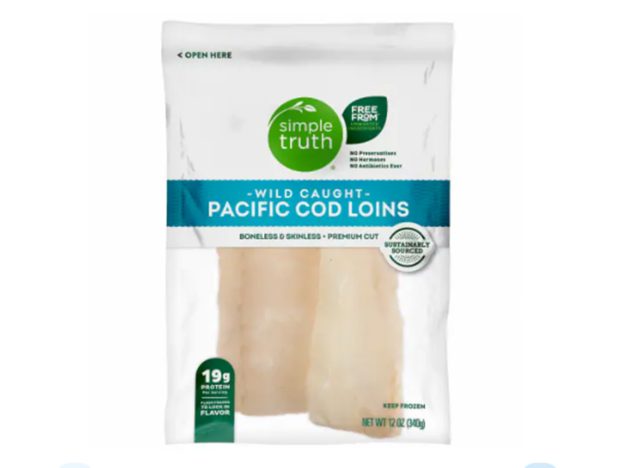
Calories: 80
Fat: 0.5 g (Saturated fat: 0 g)
Sodium: 115 mg
Carbs: 0 g
Protein: 19 g
Simple Truth Wild Caught Pacific Cod Loins are as simple as frozen seafood products come. With just one ingredient – Pacific cod – they're free from preservatives, hormones, and antibiotics. They contain just 5% of your daily sodium allowance, and a 4-ounce serving contains only 80 calories for 19 grams of lean protein. Cod has a delicate flavor, so it doesn't need a lot of seasoning. Simple herbs, lemon, and a drizzle of olive oil are often enough.
Best: Whole Foods Market Medium Wild-Caught Pink Shrimp
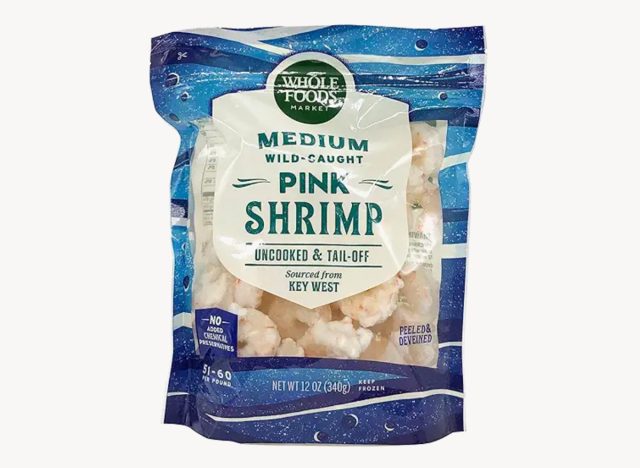
Calories: 100
Fat: 0.5 g (Saturated fat: 0 g)
Sodium: 135 mg
Carbs: 0 g
Protein: 23 g
Whole Foods Market Medium Wild-Caught Pink Shrimp were the lowest-sodium frozen, uncooked shrimp product. At just 135 mg of sodium per four-ounce serving (about 6% of your daily recommended intake) and 0.5 grams of fat, they're a good choice for the heart-health-conscious consumer. Thread onto skewers with chunks of pineapple, bell peppers, and red onions, or grill them in olive oil, lemon juice, and garlic to bring out their sweet flavor.
Best: Great Value Skinless & Boneless Tilapia Fillets
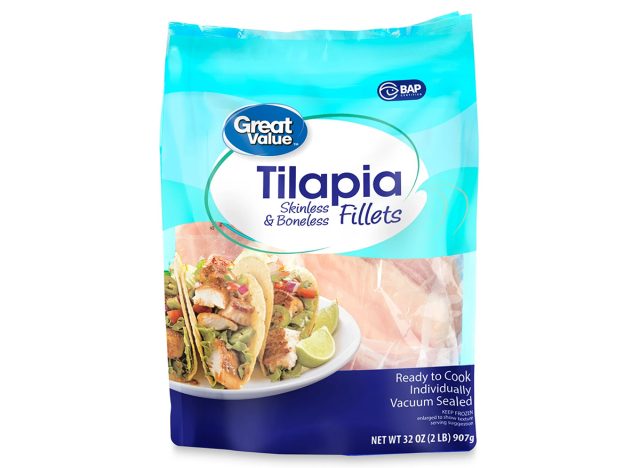
Calories: 90
Fat: 1.5 g (Saturated fat: 0.5 g)
Sodium: 40 mg
Carbs: 0 g
Protein: 19 g
If you're looking for a low-cost, healthy frozen seafood option, consider Great Value Skinless & Boneless Tilapia Fillets. These fillets are low-fat, low-sodium, and low-calorie, and with their mild flavor, they're a versatile lean protein that lends itself to countless preparations. Use them to make fish tacos by seasoning them with chili powder, cumin, and garlic powder, then pan-searing them until cooked. Serve on corn tortillas with cabbage slaw, avocado, and a squeeze of lime juice.
Best: Sam's Choice All Natural Wild Caught Mahi-Mahi
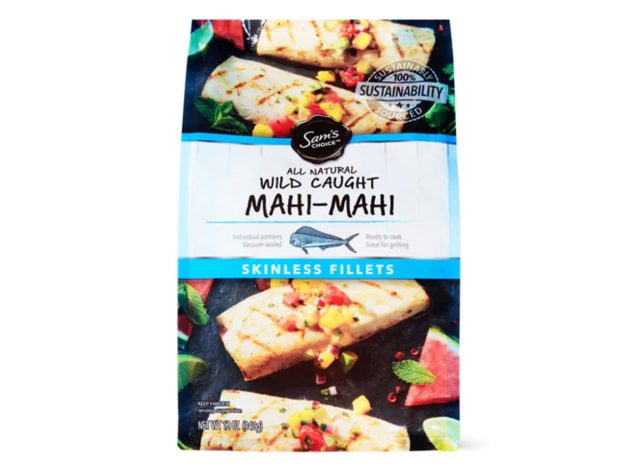
Calories: 100
Fat: 1 g (Saturated fat: 0 g)
Sodium: 100 mg
Carbs: 0 g
Protein: 21 g
Sam's Choice All Natural Wild Caught Mahi-Mahi is a smart choice when you want a frozen fish product that isn't coated in greasy breading. These skinless fillets are individually vacuum-sealed to maintain the highest amount of freshness. They contain just one gram of total fat and no saturated or trans fat, making them an excellent lean protein source. They also contain just 100 mg of sodium, about 4% of your daily recommended allowance. Season them with lemon juice and garlic to bring out their sweet flavor, and serve alongside grilled asparagus and quinoa for a well-rounded meal.
- Source: https://www.fda.gov/food/consumers/advice-about-eating-fish
- Source: https://www.fda.gov/food/consumers/advice-about-eating-fish
- Source: https://www.ncbi.nlm.nih.gov/pmc/articles/PMC7941252/
- Source: https://www.dietaryguidelines.gov/sites/default/files/2020-12/Dietary_Guidelines_for_Americans_2020-2025.pdf#page=154.06
- Source: https://www.heart.org/en/healthy-living/healthy-eating/eat-smart/sodium/how-much-sodium-should-i-eat-per-day
- Source: https://www.heart.org/en/healthy-living/healthy-eating/eat-smart/sodium/how-much-sodium-should-i-eat-per-day
- Source: https://pubmed.ncbi.nlm.nih.gov/33351135/
- Source: https://www.dietaryguidelines.gov/sites/default/files/2020-12/Dietary_Guidelines_for_Americans_2020-2025.pdf#page=154.06
- Source: https://www.heart.org/en/healthy-living/healthy-eating/eat-smart/fats/trans-fat
- Source: https://pubmed.ncbi.nlm.nih.gov/34139473/









